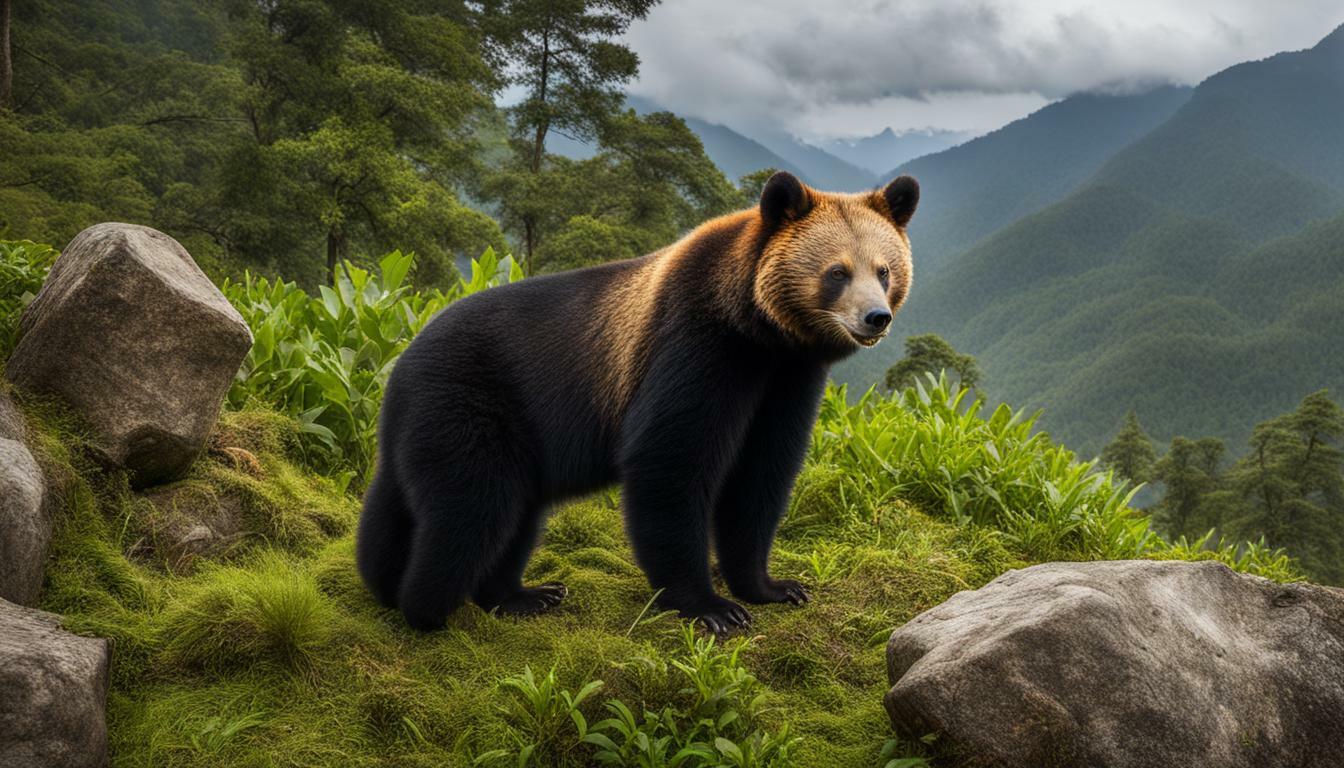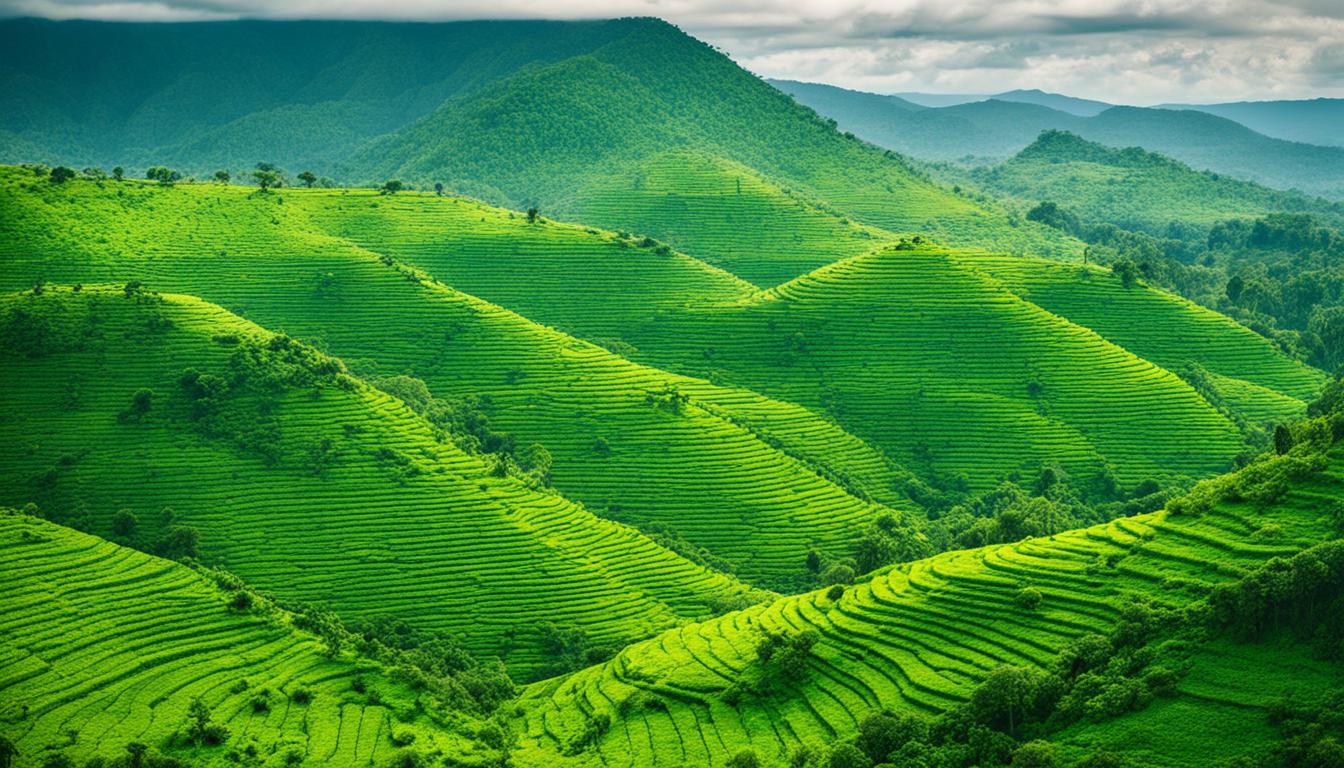Benin Biodiversity: Animal and Plant Species and What Is Under Threat
Benin, a country located in Western Africa, is known for its rich biodiversity and diverse animal and plant species. The country is home to a wide range of flora and fauna, making it an important hotspot for wildlife conservation and ecosystem protection. However, this biodiversity is currently under threat due to various factors.
Key Takeaways:
- Benin’s biodiversity is characterized by its diverse animal and plant species.
- Conservation efforts are crucial to protect the country’s endangered species and preserve its ecological balance.
- Riparian forests play a vital role in supporting Benin’s biodiversity and are under threat due to deforestation and habitat loss.
- The main threats to Benin’s biodiversity include deforestation, habitat loss, and overexploitation of natural resources.
- Conservation projects and nature reserves in Benin are working towards preserving the country’s biodiversity.
- Preserving Benin’s biodiversity is essential for maintaining ecological balance and supporting sustainable development.
The Importance of Riparian Forests in Benin’s Biodiversity
Riparian forests play a crucial role in Benin’s biodiversity, providing habitat for numerous plant and animal species and contributing to the overall ecological balance. These forests, located along waterways in Benin, are of great ecological and economic importance. They are rich in flora and fauna, with at least one-third of Benin’s estimated 3,000 plant species found in riparian forests. These forests are comparable to tropical dense forests in terms of family richness, species richness, and diversity indices, making them a significant conservation site.
The riparian forests in Benin are characterized by their location along rivers or streams and their combination of terrestrial vegetation, animal life, microclimate, and water and soil processes. They have a multi-layered vegetation structure dominated by moist-dependent trees, along with various understorey, shrub, and ground cover species. These forests also include plant species from both forest and savanna ecosystems, making them more diverse than single-ecosystem-based vegetation. They serve as a refuge for many organisms, providing ample food and substrate.
However, riparian forests in Benin are facing threats due to shifting cultivation, grazing, selective cutting of valuable tree species, road and dam construction, and the over-exploitation of non-timber forest products. These activities have led to the degradation and fragmentation of riparian forests, posing a risk to rare plant and animal species. The narrow and linear shape of these forests, combined with their ecological richness, makes their conservation a challenge that requires collaboration between conservationists and local communities.
| Riparian Forest Characteristics | |
|---|---|
| Location | Along rivers or streams |
| Main Vegetation | Moist-dependent trees |
| Understorey | Shrub and ground cover species |
| Life Forms | Phanerophytes, lianas, and therophytes |
| Physiognomy | Variable height, dense understorey |
| Floristic Composition | Region-specific moisture-dependent species |
The presence of riparian forests adapted to moist soil and water availability, combined with their structural heterogeneity and species complexity, makes them a suitable refuge for many organisms.
Efforts are being made to protect and conserve riparian forests in Benin. Legislation has been enacted to prevent further degradation, with specific regulations prohibiting the clearance of wood and shrubs within a certain distance from waterways. However, effective enforcement of these laws remains a challenge. Integration of sacred forests, many of which are riparian forests, into the protected area system is also being explored as a form of co-management that incorporates traditional knowledge and practices, along with modern science.

In conclusion, riparian forests in Benin play a vital role in preserving the country’s biodiversity. Their destruction and degradation pose a threat to rare plant and animal species and disrupt the ecological balance. It is crucial to continue conservation efforts and involve local communities in the protection and sustainable management of these valuable ecosystems.
Threats to Benin’s Biodiversity
Despite its rich biodiversity, Benin’s ecosystems are under threat from various factors, posing a significant risk to the survival of many plant and animal species. One of the major threats to Benin’s biodiversity is deforestation, which is driven by shifting cultivation, selective cutting of valuable or rare tree species, and the construction of roads and dams. These activities lead to the loss of habitat for many species and disrupt the ecological balance.
Another significant threat is habitat loss, particularly in riparian forests. Riparian forests in Benin, which are located along rivers and streams, are home to a diverse range of plant and animal species. However, these forests are being degraded and fragmented due to human activities such as overuse and improper exploitation. As a result, the rare and endemic species that rely on these forests are at risk of extinction.
The overexploitation of natural resources is also a major threat to Benin’s biodiversity. The local communities in Benin heavily rely on non-timber forest products for their basic needs and as a source of income. However, the unsustainable use of these resources, such as medicinal plants, has put pressure on the ecosystems and led to a decline in the population of certain species.
Overall, the threats to Benin’s biodiversity require urgent conservation efforts and the implementation of effective management strategies. It is crucial to address the root causes of deforestation, promote sustainable land use practices, and raise awareness about the importance of biodiversity preservation. By protecting Benin’s ecosystems and endangered species, we can maintain the ecological balance and ensure the sustainable development of the country.
| Threats to Benin’s Biodiversity |
|---|
| Deforestation |
| Habitat Loss |
| Overexploitation of Natural Resources |
As A.K. Natta, B. Sinsin, and L.J.G. van der Maesen (2002) stated, “To control the current degradation trend of the remaining riparian forests is a challenge for conservationists that should be faced together with local people.” This highlights the importance of involving local communities in conservation projects to create a sustainable and collaborative approach to biodiversity preservation.
Conservation Efforts and Nature Reserves in Benin
In order to protect and preserve Benin’s biodiversity, the country has established various nature reserves and implemented conservation projects to safeguard threatened species and their habitats. One notable example is the W National Park, a transboundary park shared among Niger, Benin, and Burkina Faso. Covering an area of 563,280 hectares in Benin, this park is part of the W-Arly-Pendjari Complex and is home to a diverse range of flora and fauna. The park’s terrestrial, semi-aquatic, and aquatic ecosystems support a rich variety of plant species, including 500 identified so far. The park also provides habitat for 70 diurnal mammal species and over 112 species of fish.

Another significant nature reserve in Benin is the Pendjari National Park, located in the far north-west of the country. Covering an area of 275,500 hectares, this park is part of the W-Arly-Pendjari Complex and is known for its scenic hills and cliffs. It has been recognized as a MAB Biosphere Reserve and a wetland of international importance. The Pendjari National Park is home to a wide range of plant and animal species, providing refuge for threatened and endangered species such as the hippopotamus and the crocodile.
Benin also has a network of sacred forests, which play a crucial role in biodiversity conservation. These forests, covering an area of 18,360 hectares, are considered refugia for numerous species and serve as seed banks and genetic reservoirs. They are managed based on cultural and religious beliefs, with strict rules and taboos to protect the forests and their resources. The government of Benin is working towards integrating sacred forests into the protected area system through a co-management approach that combines traditional knowledge and modern science.
Nature Reserves and Conservation Projects in Benin
Alongside the establishment of nature reserves, Benin has implemented various conservation projects to protect its biodiversity. These projects focus on addressing the threats facing the country’s ecosystems, including deforestation, habitat loss, and overexploitation of natural resources. One project of note is the conservation efforts to protect riparian forests in Benin. These forests are crucial for ecological and economic reasons, supporting a wide range of plant and animal species. Efforts are being made to control the current degradation trend of riparian forests through collaboration between conservationists and local communities.
In conclusion, Benin recognizes the importance of biodiversity preservation and has taken significant steps to protect its natural heritage. With the establishment of nature reserves and the implementation of conservation projects, the country is working towards maintaining ecological balance and promoting sustainable development. However, it is crucial to continue supporting these efforts and raise awareness about the significance of preserving Benin’s biodiversity for future generations.
| Nature Reserves | Location |
|---|---|
| W National Park | Transboundary park shared among Niger, Benin, and Burkina Faso |
| Pendjari National Park | Far north-west of Benin |
The Importance of Biodiversity Preservation in Benin
Preserving Benin’s biodiversity is crucial not only for the survival of unique animal and plant species but also for maintaining healthy ecosystems, supporting wildlife conservation efforts, and ensuring the long-term sustainability of the country. Benin is known for its rich biodiversity, with diverse ecosystems ranging from riparian forests to savannas, providing habitats for a wide range of species.
Riparian forests, in particular, play a vital role in Benin’s biodiversity. These forests, found along rivers and streams, are home to a significant portion of the country’s flora and fauna. They harbor at least one-third of Benin’s estimated 3,000 plant species, including valuable, rare, and even endemic species. Riparian forests also support a diverse array of animal life, providing ample food and substrate, making them a suitable refuge for many organisms.
Despite their ecological importance, riparian forests in Benin are facing threats from human activities such as shifting cultivation, grazing, selective cutting of valuable tree species, road construction, and overexploitation of non-timber forest products. These activities have led to the degradation and fragmentation of riparian forests, putting at risk the rare plants and animals that rely on them. Conservation efforts are therefore essential to protect and restore these fragile ecosystems.
The government of Benin, recognizing the significance of biodiversity preservation, has initiated various conservation projects and established nature reserves to safeguard the country’s ecosystems and wildlife habitats. These conservation initiatives aim to mitigate the threats facing Benin’s biodiversity and promote sustainable resource management. By protecting and managing these areas, Benin can ensure the long-term viability of its precious biodiversity.
| Key Points | Summary |
|---|---|
| Riparian forests are crucial for Benin’s biodiversity | These forests are rich in flora and fauna, supporting a wide range of species |
| Threats to Benin’s biodiversity | Human activities, such as deforestation and overexploitation, are endangering the country’s ecosystems |
| Conservation efforts and nature reserves | Various projects and protected areas are working towards preserving Benin’s biodiversity |
| The importance of biodiversity preservation | Preserving Benin’s biodiversity is crucial for ecological balance and sustainable development |
Quote:
“To control the current degradation trend of the remaining riparian forests is a challenge for conservationists that should be faced together with local people.” – A.K. Natta, B. Sinsin, and L.J.G. van der Maesen
In conclusion, preserving Benin’s biodiversity is not only a responsibility but also an opportunity to protect the country’s natural heritage and promote sustainable development. By conserving ecosystems, such as riparian forests, and implementing effective conservation projects, Benin can ensure the survival of its unique animal and plant species, maintain ecological balance, and support the well-being of both its people and wildlife.

Conclusion
In conclusion, Benin’s biodiversity is a valuable asset that requires urgent conservation efforts to protect endangered species, preserve natural habitats, and maintain the ecological balance for the benefit of present and future generations. The country’s riparian forests, which form a dominant ecosystem, play a crucial role in supporting a wide range of plant and animal species. However, these forests are facing severe misuse and degradation due to deforestation and overexploitation of resources.
The threats to Benin’s biodiversity are diverse and include deforestation, habitat loss, and overexploitation of non-timber forest products. These activities not only endanger rare plants and animals but also disrupt the ecological balance. It is essential to address these challenges through sustainable conservation initiatives and the involvement of local communities.
Fortunately, there are conservation projects and nature reserves in Benin that are working towards preserving the country’s biodiversity. These initiatives aim to protect and restore riparian forests, as well as other important ecosystems, to ensure the survival of valuable and rare species. However, the enforcement of legislation and the effective management of these protected areas require continued support and collaboration.
The importance of biodiversity preservation in Benin cannot be overstated. It is not only crucial for maintaining ecological balance but also for supporting sustainable development. Biodiversity provides numerous ecosystem services, such as pollination, water purification, and carbon sequestration, which are essential for human well-being. By conserving Benin’s biodiversity, we can safeguard the country’s natural heritage and contribute to a more sustainable future.
FAQ
Q: What is the importance of riparian forests in Benin?
A: Riparian forests in Benin play a crucial role in supporting a wide range of plant and animal species. They provide a suitable refuge for many organisms due to their structural complexity, abundant food sources, and proximity to water. These forests are rich in biodiversity, harboring at least one-third of the estimated flora of Benin.
Q: What are the main threats to Benin’s biodiversity?
A: The main threats to Benin’s biodiversity include deforestation, habitat loss, and overexploitation of natural resources. Shifting cultivation, grazing, selective tree-cutting, road and dam construction, and the over-exploitation of non-timber forest products all contribute to the degradation of ecosystems and the endangerment of rare plants and animals.
Q: What conservation efforts are being made in Benin?
A: There are various conservation projects and nature reserves in Benin that are working towards preserving the country’s biodiversity. These initiatives aim to protect and restore ecosystems, promote sustainable practices, and raise awareness about the importance of conserving biodiversity.
Q: Why is biodiversity preservation important in Benin?
A: Biodiversity preservation is crucial in Benin for maintaining ecological balance and supporting sustainable development. Preserving diverse ecosystems and species ensures the provision of essential ecosystem services, such as clean air and water, fertile soils, and natural resources that support the livelihoods of local communities.







